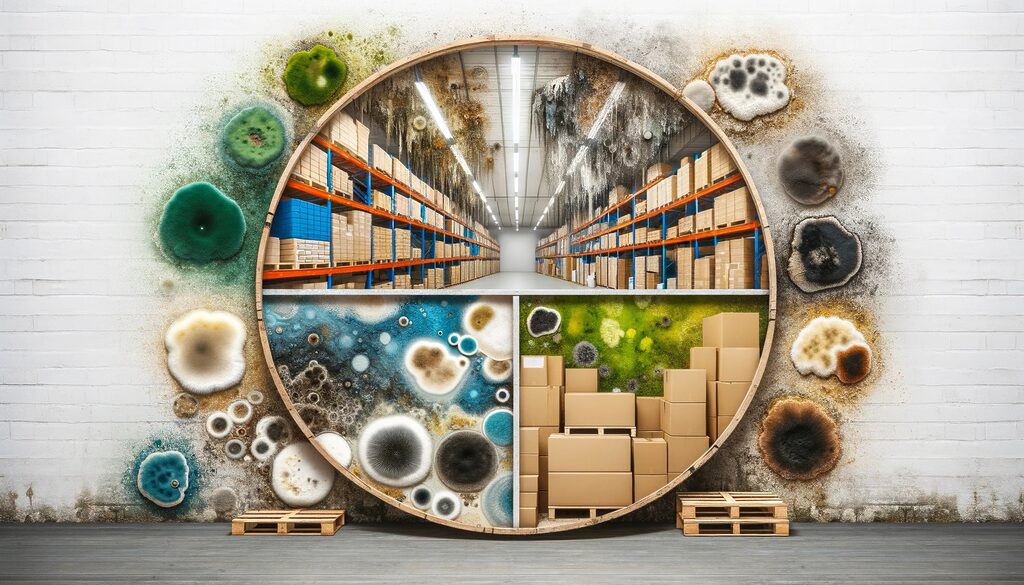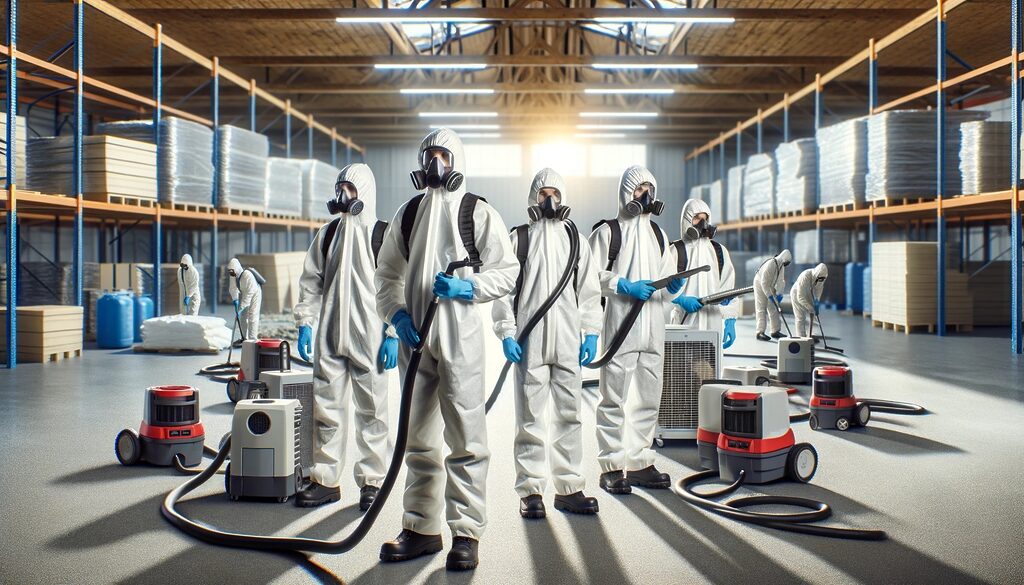In today’s fast-paced market, ensuring the safety and integrity of our warehouse spaces, including equipment, commercial buildings, and their indoor environment and rooms, is crucial. We understand the importance of conducting a thorough mold inspection for warehouses, as it safeguards our products, employees, and business reputation. Mold, often signaled by a musty odor, water leak, or condensation, can compromise not only structural integrity but also air quality, making its early detection and removal in the remediation zone paramount. Our commitment to maintaining a clean, healthy environment drives us to prioritize regular inspections, including mold testing, air testing, and addressing indoor air quality and mold contamination. This process helps us identify potential issues before they escalate, ensuring our operations remain uninterrupted and efficient.
For comprehensive information and guidance on safeguarding your warehouse against mold, visit our mold inspection services homepage.
Importance of Mold Inspection in Warehouses
Prevents Contamination
Mold inspections are crucial for us. They help stop mold from ruining our products. When mold grows, it can spread quickly. This ruins many items stored in warehouses.
By checking for mold, we keep our goods safe. This means we don’t lose money on damaged items. It’s a key step to protect our home and project, the house and water we have worked hard for.
Ensures Health
A healthy workplace is important to us all. Mold can make the air unhealthy in warehouses. This is bad for everyone working there.
Regular mold inspections can find and remove mold fast. This keeps the air and water clean and safe for us to breathe, preventing condensation and mold spores from forming outside. It shows we care about each other’s well-being.
Avoids Damages
Warehouses can suffer from mold damage too. Moisture often causes this problem. If left unchecked, it leads to big repair bills.
Inspections spot early signs of moisture and mold, including condensation and water leak testing, using tools like tape lift tests. Fixing these water leak issues early in the house saves a lot of money later on and results in fewer problems.
Learn how you can start the mold inspection process remotely by taking advantage of our free virtual mold inspection service.
Identifying Common Types of Mold in Warehouses

Black Mold
Black mold is a big problem in warehouses. It loves places that are very wet. We often see mold growth on walls in the basement where water leaks or where the air is too damp, due to mold spores, necessitating mold testing.
To find black mold, we use something called a tape lift sample. This helps us know for sure if the dark spots we see are harmful black mold.
White Mold
White mold grows best on wood and cardboard. In our warehouse, we found it hiding on old wooden pallets and boxes that were forgotten in a corner outside in the area, where samples of mold spores were discovered.
This type of mold can spread fast if not taken care of quickly. We make sure to check these materials often to keep white mold away.
Aspergillus Species
Aspergillus is another common type of mold in warehouses. It likes areas that are dusty and have good airflow but are still inside, like under big fans or near open windows.
We learned that cleaning dust regularly can help prevent aspergillus from growing. Making sure our warehouse has good air movement but not too much dust makes a big difference.
Effective Mold Removal Strategies

Antifungal Treatments
We’ve learned that applying antifungal treatments to affected surfaces is crucial. This method directly targets the mold, stopping its growth. It’s a technique we rely on heavily. The right antifungal product can make all the difference.
Choosing an effective treatment requires knowing what type of mold we’re dealing with. After identifying common molds in warehouses, we match the treatment to the specific mold type. This ensures success in our remediation projects.
Discover the best practices and professional services for mold removal in warehouses to ensure a safe and clean environment for your operations.
Dehumidifiers Use
Implementing dehumidifiers has been a game-changer for us. These devices control humidity levels, making the space less inviting for mold growth. We place dehumidifiers strategically throughout the warehouse to maintain low moisture levels.
Keeping humidity under control reduces mold spore counts and exposure risks significantly, thereby inhibiting mold growth and necessitating less frequent testing and sampling. It’s one of those proactive steps that truly pays off in maintaining a healthy environment.
Ventilation Maintenance
Regular cleaning and maintenance of ventilation systems are non-negotiable for us. A well-maintained system improves air quality and reduces odor caused by mold, like chaetomium.
This work involves checking filters and ensuring vents are clear of blockages. It’s hard work but necessary to prevent elevated levels of spores from circulating inside our space.
Key Steps for Mold Prevention
Proper Ventilation
Ensuring proper warehouse ventilation is crucial. We’ve found that airflow helps keep moisture levels down. This reduces mold growth risks. Fans and dehumidifiers are great tools for this.
Ventilation systems need regular checks too. We make sure they’re always working right.
Leak Repairs
Leaks can be a big problem in warehouses. They let water in, which mold loves. Regularly inspecting the building helps us find leaks early.
We fix leaks as soon as we spot them. This keeps our warehouse dry and safe from mold.
Humidity Control
Keeping humidity below 50% is important for us. High humidity means more chances for mold to grow. We use hygrometers to check the air’s moisture level often.
Dehumidifiers help us control humidity well. They make our warehouse safer by lowering the risk of mold.
Professional Mold Inspection Services
Advanced Tools
We’ve learned the hard way that mold inspection for warehouses isn’t just about spotting visible mold. It’s about understanding what lurks beneath surfaces and within walls. That’s why professional services use advanced tools.
These tools, like moisture meters and devices for indoor air quality testing, help find mold we can’t see. They detect water leaks and moisture that could lead to mold growth. This is crucial in preventing major mold contamination.
Professionals also perform thorough mold testing. This includes taking samples of air and surfaces to measure mold levels. These tests show if our warehouse has a problem with molds, including dangerous black mold.
Expert Recommendations
After finding any signs of mold, professionals give us detailed advice on how to get rid of it. They tell us about the best methods for mold remediation based on their findings.
They might suggest specific cleaning agents or professional services to remove the mold safely. Also, they offer tips on fixing water damage or leaks that caused the issue.
Ongoing Support
One thing we appreciate is the ongoing support from these services. After initial treatment, they provide strategies to keep our warehouse free from future outbreaks.
This includes regular check-ups and advice on maintaining good indoor air quality. They stress the importance of controlling humidity levels and ensuring proper ventilation.
Factors Affecting Cost of Mold Inspection and Removal
Warehouse Size
The size of our warehouse greatly influences the cost. Larger areas demand more time for a thorough inspection. They also require more materials for mold removal.
A bigger space means higher fees. It’s simple math. But, we understand it’s necessary to ensure a safe environment for everyone.
Mold Type
Different molds present unique challenges. Some types are harder to remove than others. This affects the cost and time needed for removal.
For instance, black mold requires special handling due to its health risks. Knowing the type helps us prepare better for the task ahead.
Additional Repairs
After removing mold, repairs might be needed. This can increase costs significantly.
- Walls or floors may need fixing.
- Ventilation systems often require updates to prevent future issues.
These repairs ensure our warehouse stays mold-free longer.
Understanding the Mold Inspection Report Summary
Types of Mold
After getting a mold inspection for our warehouse, we received a report. It was detailed. The report listed specific types of mold found.
Some molds were common. Others were rare. Each type affects air quality differently. Knowing them helps us decide on action.
Severity and Locations
The report showed where mold grew most. Some areas had more mold than others.
It also rated the severity. This told us how bad the situation was. High counts meant urgent action was needed.
Remediation Steps
The report recommended steps to fix the problem. First, remove all visible mold. Then, address moisture sources to prevent future growth.
For long-term prevention, regular inspections are key. They catch problems early.
Final Remarks
We’ve explored the critical importance of mold inspection in warehouses, delving into the common types of mold, effective removal strategies, and prevention steps. Understanding these elements is vital for maintaining a safe and healthy warehouse environment. Mold inspection not only safeguards our health but also protects the integrity of stored goods, ultimately supporting operational efficiency and business reputation. The insights from professional mold inspection services and the detailed analysis provided in the mold inspection report summary are indispensable tools for us to make informed decisions.
Let’s take action by scheduling regular mold inspections and implementing the recommended prevention strategies. By doing so, we ensure a proactive approach to mold management, contributing to a safer workplace for everyone. Remember, addressing mold issues promptly can save us time and resources in the long run. Let’s work together to maintain mold-free warehouses.
Find a professional mold inspection service near you by visiting our mold inspection locations page.
Frequently Asked Questions
1. What is the importance of mold inspection in warehouses?
Mold inspections are crucial in warehouses to prevent product damage, safeguard worker health, and maintain structural integrity. They identify potential issues early, avoiding costly repairs.
2. How can one identify common types of mold in warehouses?
Common molds include Cladosporium, Aspergillus, and Penicillium. Identification involves visual inspection and sometimes laboratory analysis for precise identification.
3. What are effective mold removal strategies for warehouses?
Effective strategies include removing contaminated materials, using antifungal agents for cleaning surfaces, and ensuring proper ventilation to reduce humidity levels.
4. What key steps should be taken for mold prevention in warehouses?
Maintain low humidity levels, ensure proper ventilation, fix leaks promptly, and conduct regular inspections to prevent mold growth.
5. Why consider professional mold inspection services?
Professionals have the expertise and equipment to accurately identify and assess mold issues, ensuring a thorough resolution that DIY approaches might miss.
6. What factors affect the cost of mold inspection and removal in warehouses?
Size of the warehouse, extent of the mold infestation, type of materials affected by mold, and geographical location influence costs significantly.
7. How does one understand a mold inspection report summary?
The summary outlines identified molds’ types, locations within the warehouse where they were found, their potential impact on health or structure if any. It also recommends actions for remediation.
